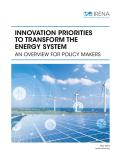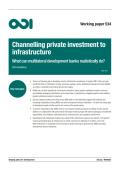
This brief, Innovation Priorities to Transform the Energy System: An overview for policy makers, provides a high-level overview of priorities to accelerate technological and systemic innovation.

This report, Finance Options and Instruments for Ecosystem-based Adaptation, provides a comprehensive outlook on available financing sources and stipulates ten examples for project developers and practitioners who might be keen to learn from different finance approaches to implement and maintain EbA measures.

This paper, Channelling Private Investment to Infrastructure, focuses specifically on the role of MDBs.
Self-insurance Against Natural Disasters: The use of pension funds in Pacific Island countries provides a normative analysis of the use of early pension withdrawals after disasters, by setting up a life-cycle saving model with myopic households facing large natural disaster shocks

Africa SDG Index and Dashboards 2018 is a tool to track progress toward the SDGs, to help pinpoint key implementation challenges, and to assist countries in benchmarking their SDG performance against their African peers.
